Pitta Kapha Diet for Weight Loss Supplements
Ayurveda, which comes from the ancient Vedic texts, is a 5,000-year-old medical philosophy and practice, predicated on the idea that we all are made up of different types of energy.
There are three doshas in Ayurveda, which describe the dominant mind/body state: Vata, Pitta, and Kapha. While all three are present in everyone, Ayurveda proposes that we each have a dominant dosha that's unwavering from birth, and ideally an equal (though often fluctuating) balance between the other two. When the doshas are balanced, we are healthy; when they are unbalanced, we develop disease, which is usually made manifest by skin issues, poor digestion, insomnia, irritability, and anxiety.
In India, Nepal, and other parts of the East, Ayurveda is considered serious medicine—with schooling that's commensurate with a Western medical degree. But unlike Western medicine, a basic evaluation goes beyond a physical exam. An Ayurvedic doctor will take your pulse, check your tongue, and assess your appearance (among other factors), and then ask you a series of questions about how you handle and respond to various scenarios. It's quite cool.
The resident Ayurvedic physician at Ananda, Dr. Chandan, shared some of the basic principles and qualities of the three doshas from Ayurveda, and how to eat for balance; meanwhile, Narendra Sharma, the executive chef behind Ananda's award-winning wellness kitchen, shared some recipes.
From the Desk of Dr. Chandan
Prakruti
This is the principle that recognizes that each human being is born with unique combinations of doshas, and that this natural balance is what is responsible for physical, mental, and emotional difference among people. By identifying and maintaining an individual's Prakruti, Ayurveda can help each person create his or her own state of ideal health.
Dosha: Vata
(Air & Space)
Vatas tend to be more spacey, anxious, with active minds. They speak quickly, and are likely to have joints that crack. Vata influences the movement of thoughts, feelings, prana flows, nerve impulses, and fluids in the body.
VATA QUALITIES:
Cold, light, dry, irregular, rough, moving, quick, and always changing. Vata governs movement in the body, the activities of the nervous system, and the process of elimination. Vata influences the other doshas. Vatas tend to always be on the go, with energetic and creative minds. When Vatas are in balance, they are lively and enthusiastic.
PHYSICAL CHARACTERISTICS OF VATA:
Thin, light frame, and excellent adaptability. Their energy comes in bursts, and they are likely to experience sudden bouts of fatigue. Vatas typically have drink skin and cold hands and feet. They sleep lightly and their digestion can be sensitive. When imbalanced, Vatas tend to experience weight loss, constipation, arthritis, weakness, restlessness, aches, and pains.
EMOTIONAL CHARACTERISTICS OF VATA:
Vatas love excitement and new experiences. They are quick to anger but also to forgive. They are energetic, creative, and flexible. They also take initiative and are lively conversationalists. When imbalanced, Vatas are prone to worry, anxiousness, nervousness, and often suffer from insomnia.
When they feel overwhelmed or stressed, their response is: "What did I do wrong?"
HOW VATAS CAN STAY BALANCED:
-
Follow the dietary guidelines in the diet below.
-
Maintain a consistent daily routine and keep exercises both gentle and regulated.
-
Find time for rest and to nurture themselves. Be in a calm, safe, and comforting environment.
-
Have regular Ayurvedic massages as this is soothing and grounding for Vatas.
-
Avoid very cold and windy conditions, as well as dry climates.
-
Minimize travel and too much movement; avoid loud and noisy places as well as crowds and too much talking.
- Keep warm and get enough sleep.
FAVORABLE FOODS:
Vata is a cold and dry dosha; warm, nourishing foods with moderately heavy texture, plus added butter and fat are good for stabilizing Vata. Choose salty, sour, and sweet tastes as well as soothing and satisfying foods. Warm milk, cream, butter, warm soups, stews, hot cereals, fresh baked bread, raw nuts, and nut butters are good for Vatas. Take a hot or herbal tea with snacks in the late afternoon. All sweet fruits (so long as they are extra-ripe) are OK for Vata. Warm drinks or hot water are best for Vatas.
Spices: Cinnamon, cardamom, cumin, ginger, cloves, and garlic are all OK for Vatas.
FOODS TO REDUCE:
Cold foods such as salads, iced drinks, raw vegetables and greens are not good for those with Vata imbalance (i.e. where Vata is dominant). Avoid drinks with too much caffeine and candies as they disturb Vata. Avoid unripe fruits, as they are too astringent.
Vata Recipes
-
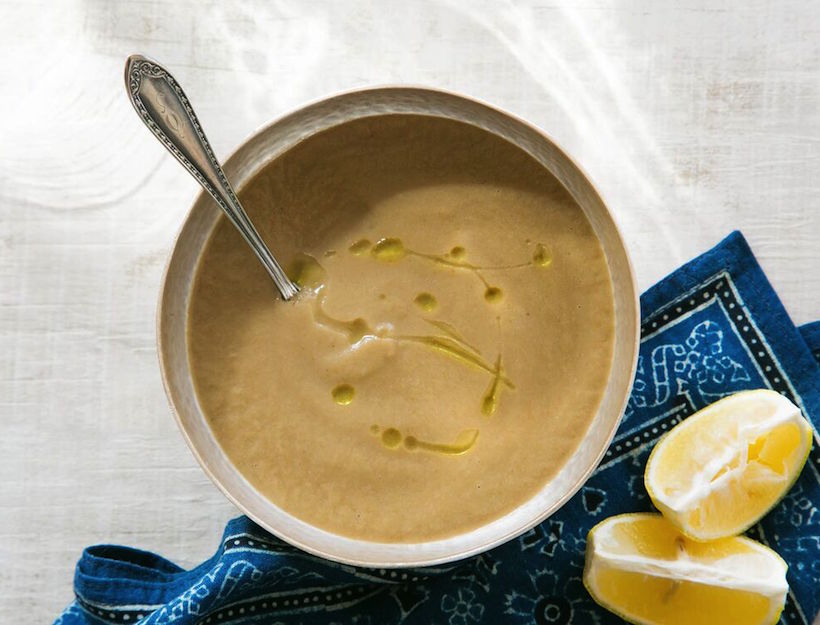
-
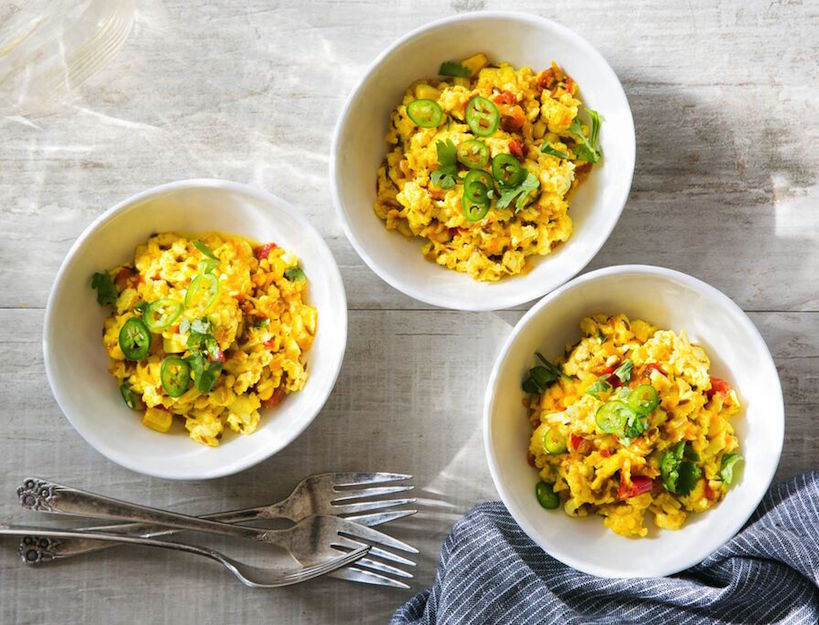
Makai Paneer Ki Bhurji
It may look like scrambled eggs, but this unique sautéed Indian cheese dish is so much more versatile. With fresh cilantro, squeaky cheese, earthy cumin seeds, and spicy chili, this Makai Paneer is our new favorite dish for breakfast, lunch, or dinner.
Get Recipe
Dosha: Pitta
(Fire & Little Water)
Pittas literally have more fire in them than other types. They have better appetites and better digestion. They can withstand the cold better, as they are hotter-headed. They are naturally aggressive and impatient, intelligent, and sharp. Since Pittas have strong and efficient digestion, they can generally eat just about everything. Most Pittas get into trouble by continued use of too much salt, overuse of sour and spicy food, and overeating.
PITTA QUALITIES:
Hot, light, intense, penetrating, pungent, sharp, and acidic. The Pitta dosha controls digestion, metabolism, and energy production. The primary function of Pitta is transformation.
PHYSICAL CHARACTERISTICS OF PITTA:
Pittas have excellent digestion and warm body temperature; they sleep soundly for short periods of time, have abundant energy, and a strong appetite. When imbalanced, Pittas may suffer from skin rashes, burning sensations, peptic ulcers, excessive body heat, heartburn, and indigestion.
EMOTIONAL CHARACTERISTICS OF PITTA:
Pittas have a powerful intellect and a strong ability to concentrate. They are good decision makers, teachers, and speakers. They are precise, sharp-witted, direct, and often outspoken. They are ambitious and practical, and love both adventure and challenges. When imbalanced, Pittas can be short-tempered, argumentative, and suffer outbursts of emotion.
When they feel overwhelmed or stressed, their response is: "What did you do wrong?"
HOW PITTAS CAN STAY BALANCED:
-
Follow the dietary guidelines in the diet below.
-
Get plenty of fresh air and choose cooler times of day to get physical exercise.
-
Keep cool physically and mentally, and apply an attitude of moderation in all things.
-
Avoid situations of excessive heat, steam, or humidity and take plenty of fluids.
-
Be considerate and patient with others.
-
Engage in quiet and contemplative activities.
-
Avoid situations of potential conflict.
FAVORABLE FOODS:
The best foods for Pittas are cool or warm, with moderately heavy textures—i.e., not steaming hot foods. Bitter, sweet, and astringent tastes are ideal. Take cool, refreshing food in summer or hot weather, like salads, milk, and ice cream. Herbal tea, specifically mint or licorice root tea are pacifying to Pittas. Cold cereal, cinnamon toast, and apple tea is a good breakfast for a Pitta. Vegetarian foods, in general, are the best for Pittas, as consuming red meat tends to heat the body from the fat. They should consume abundant amounts of milk, grains, and vegetables.
FOODS TO REDUCE:
Pittas should use less butter and added fat, and they should avoid pickles, sour cream, and cheese. They should also avoid vinegar in salad dressing and use lemon juice instead. Alcoholic and fermented foods should be avoided. Reduce coffee. Avoid oily, hot, salty, and heavy foods such as anything fried. Pittas should also skip egg yolks, nuts, hot spices, honey, and hot drinks.
Pitta Recipes
-

Dal Shorba
This comforting soup is perfect on a chilly fall afternoon. We used split red lentils, which don't need soaking, but be sure to read the directions on the package. Some need to soak for about an hour before cooking.
Get Recipe
-
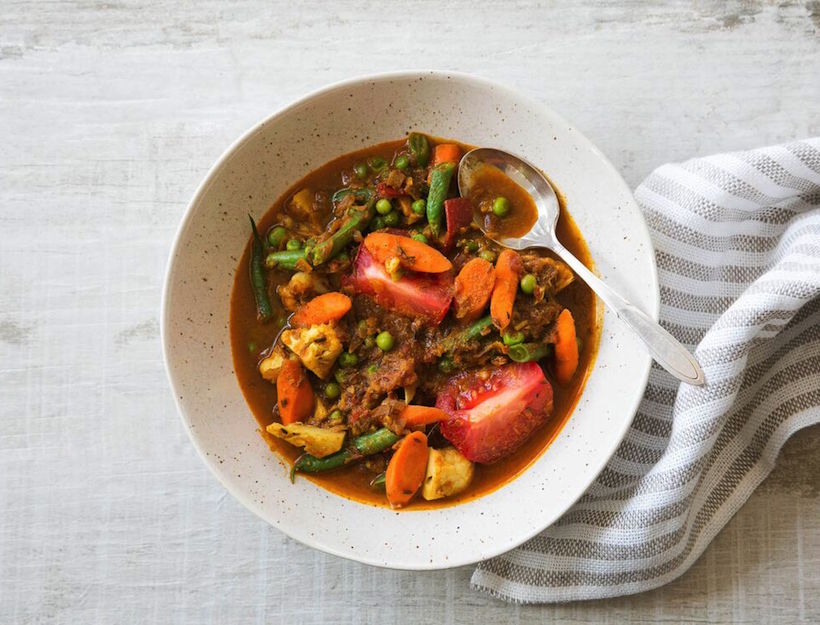
Vegetable Curry
The spices in this vegetable curry lend incredible flavor, and it comes together in about 30 minutes. Serve over rice or with naan to soak up the juices.
Get Recipe
Dosha: Kapha
(Earth & Water)
Kaphas tend to have heavier, earthier bodies than other types, and tend to store watery substances like fluids and fat more readily. They are naturally calm and attached; A Kapha speaks slowly and melodically. They sometimes have watery dreams, and tend to have elimination that is thick and heavy.
KAPHA QUALITIES:
Heavy, slow, steady, solid, cold, soft, and oily. Kapha governs the structure of the body. It is the principle that holds the cells together and forms the muscle, fat, bone, and provides immunity. The primary function of Kapha is protection.
Kaphas have a strong build and excellent stamina as well as smooth, radiant skin. They sleep soundly and have regular digestion. But when Kapha build to excess they can gain weight, retain fluid, and allergies manifest in the body. When imbalances, Kaphas may become overweight, sleep excessively, become lethargic, and suffer from asthma, diabetes, and depression.
EMOTIONAL CHARACTERISTICS OF KAPHA:
Kaphas are naturally calm, thoughtful, and loving. They have an inherent ability to enjoy life and are comfortable with routine. Kaphas are strong, loyal, patient, steady, and supportive. They love music, reading, and relaxing. When imbalanced, they tend to hold on to things, jobs, and relationships long after they are no longer present. They display excessive attachment. When imbalanced, Kaphas become stubborn and resist change.
When they feel overwhelmed or stressed, their response is: "I don't want to be involved."
HOW KAPHAS CAN STAY BALANCED:
-
Follow the dietary guidelines in the diet below.
-
Wake early (before dawn), sleep less, and avoid sleeping during the day.
-
Indulge in plenty of physical exercise every day.
-
Perform activities that stimulate and energize the body and mind, and build the metabolic rate.
-
Allow for excitement, challenge, and variety in life.
-
Break away from stagnation and clinging to old ways of thinking and behaving.
-
Keep warm and dry.
FAVORABLE FOODS:
Warm, light, and dry food is favorable, or cooked light meals. Kaphas do best with lightly cooked foods or raw fruits and vegetables. Any food that is spicy is good for Kaphas such as very hot Mexican or Indian food, especially in winter. Dry cooking methods (baking, broiling, grilling, sautéing) are preferable for Kaphas over moist cooking such as steaming, boiling, or poaching. Foods such as romaine lettuce, endive, or tonic water are good for stimulating the Kapha appetite, while preferred spices are cumin, fenugreek, sesame seed, and turmeric.
FOODS TO REDUCE:
Kaphas need to watch the consumption of too many sweet and fatty foods, and need to watch their salt consumption as well, as it can lead to fluid retention. They should avoid deep-fried foods. A typical Kapha tendency is to overeat: The main meal should be at the middle of the day, and only a light, dry meal in the evening. In general, Kaphas should avoid sugar, fats, and dairy products, skip chilled foods and drinks, and use ghee and oils in small amounts only.
Kapha Recipes
-
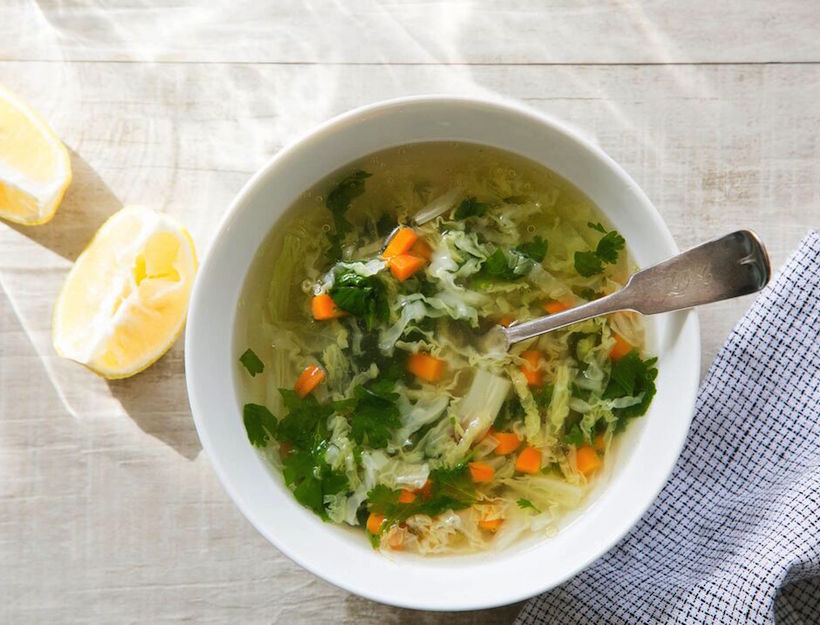
-
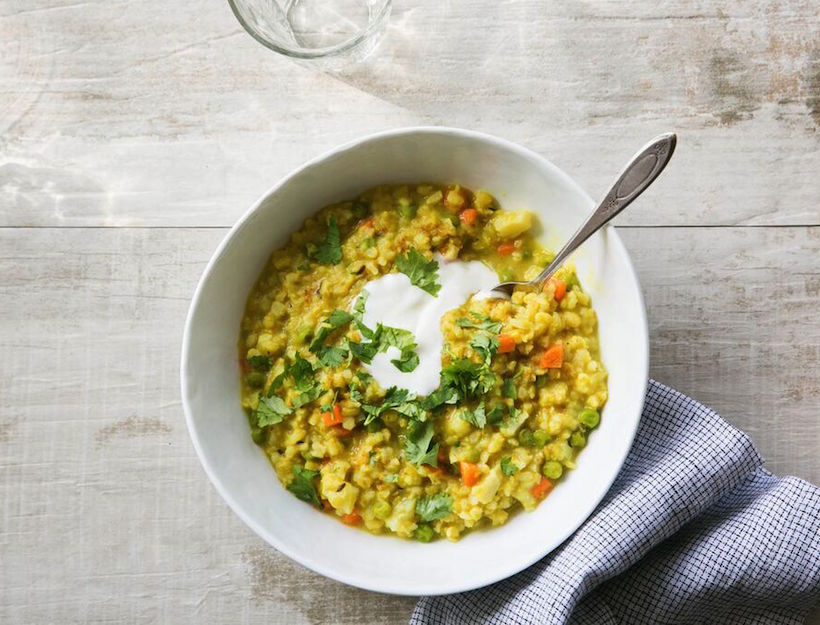
Brown Rice Khichdi
Brown rice and lentils pack a serious nutritional punch and the addition of veggies, spices, ginger and cilantro make this healthy recipe one that the whole family will happily chow down on.
Get Recipe
Dr. Chandanis a native of Bengaluru in Southern India, and an Ayurvedic Medicine & Surgery graduate. After his bachelors degree, he earned his Post Graduate Certification in Panchakarma from Manipal University in India. He is also certified in yoga by the Bihar School of Yoga. He practiced as a full-time Ayurvedic doctor and Panchakarma specialist in Bangalore for more than 6 years, and managed Ayurvedic clinics and hospitals throughout the country. He has been with Ananda for three years.
The views expressed in this article intend to highlight alternative studies and induce conversation. They are the views of the author and do not necessarily represent the views of Goop, and are for informational purposes only, even if and to the extent that it features the advice of physicians and medical practitioners. This article is not, nor is it intended to be, a substitute for professional medical advice, diagnosis or treatment and should never not be relied upon for specific medical advice.
Pitta Kapha Diet for Weight Loss Supplements
Source: https://goop.com/food/recipes/ayurveda-how-to-eat-for-your-dosha/
0 Response to "Pitta Kapha Diet for Weight Loss Supplements"
Post a Comment